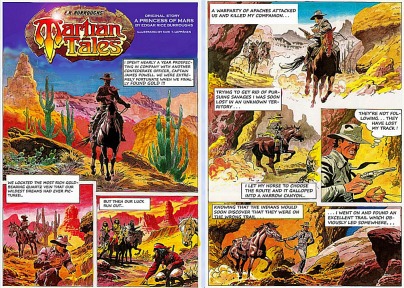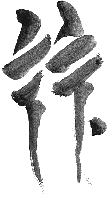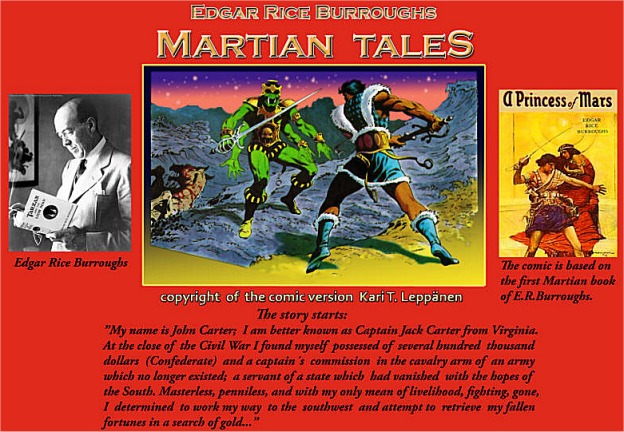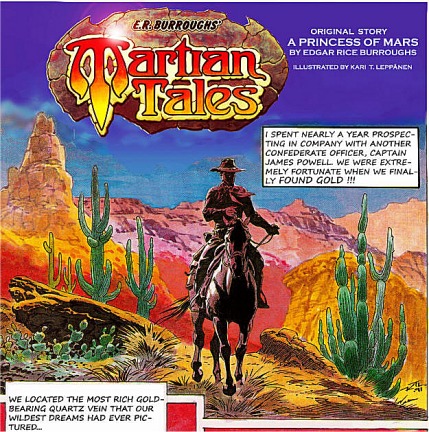Fredrik Ekman: In
1991, the first instalment of your John Carter comic was published in Portti.
Could you describe the background leading up to that publication? Why Portti,
and why at that specific time?
Kari Leppänen: That first publication of my
comic adaptation from ERB’s first Martian book happened some twenty years
ago and after that I’ve done lots of comics besides going on with John
Carter, which has been published very slowly. So I will tell you what I
remember from that period ...
In 1991 I had recently moved back to Finland from Canary
Islands where I lived some six years. From there I sent cover illustrations
and pictures for Portti’s stories, and that went on when
I was back in Finland. Why I started such a hard job as turning A
Princess of Mars into comic form, I do not clearly remember. That
idea had been in my mind for years, but I hadn’t done anything because
a coloured comic could be too expensive for Finnish publishers and I had
no idea where to send it.
I had drawn a coloured version of the same book years
ago just for myself and for a couple of readers among my relatives, about
the last years of the 60s. So I was willing to make a better version when
I thought that I was more capable to do so.
Probably in 1990 I discussed with the editor of Portti
if he was interested in having a coloured comic in his magazine and I offered
to him my Martian work. There had been only four comics in his magazine
since he had started it in 1982, and he appeared quite interested about
the possibility to have a such a well-known subject in the pages of Portti.
Having gotten the first pages of the comic he raised an
idea that the issue where he was planning to publish it could be an Edgar
Rice Burroughs special. He asked if I would like to write an article about
ERB and in the end I wrote three articles which were published together
with my first John Carter of Mars comic.
You asked why it was Portti that published
John Carter. Well, I didn’t know any other who could take a coloured
work. I had done some minor works for another Finnish scifi magazine in
black-and-white and I knew that if those fan magazines take comics, the
payment was nothing or very few coins. The editor of Portti
was willing to pay almost a reasonable fee and it was the only Finnish
scifi magazine that published colour pages. During those years I didn’t
have any contacts with any other publishers in Finland (actually I do not
have any even now) because my principal work was making comics for Sweden.
Between the third and
fourth instalment, there was a gap of eight years, and then for the past
ten years there have been no new instalments published (leaving John Carter
stranded in Thark). What were the reasons for those long delays?
I really do not know the true reason, because the long
gap in the publication of this story has not been in my hands. During that
eight year gap I often asked the editor of Portti when he
could take the next John Carter pages in his magazine, but his answer was
always the same. He referred to a matter that he wanted to bring out the
next part of John Carter in the issue where an interview about me was included.
To explain it more; a Finnish artist who is living in
Portugal had promised to write an interview of my career as a scifi artist
sometime in 1992, but with difficulties in his life and work he has not
been capable of finishing it until this year. For some reason of his own
the editor of Portti has decided to postpone the publication
of John Carter till he could publish also this damned interview. I have
been very disappointed with that, because when I started this work I had
in my mind that I could handle at least ERB’s first Martian book.
Now it seems to be impossible.
The interview and John Carter (I was forced to change
the title to Hero of Mars in Portti because the copyright
of the original name was purchased by the makers of the Disney movie) are
coming in printed form during this year. [Fredrik’s comment: The fifth
instalment was finally published in Portti 2/2013, but nothing
further has been published since then.] There are 20 pages stored in
the archives of Portti since I made them in 1995, but I do
not know if those all are coming in the same issue of Portti.
What particular difficulties
did you encounter in adapting John Carter to the comic medium?
It may sound surprising, but I do not recall having any
particular difficulties while adapting ERB’s work into pictures. I had
done it before in my youth and the same very clear image which I had in
my mind from the book that I had read at least ten times was still alive
in my mind. The way Burroughs described the details of his Barsoom left
the reader to imagine that world and its creatures the way he liked, just
to remember how many legs they have. As in my other scifi works, hardcore
and fantasy, it is always easier when I can draw things from my imagination
and it also makes the work more enjoyable. Of course there were descriptions
how Barsoomian creatures looked like, but that was not difficult to turn
into your own pictures of them. Maybe the thorough knowledge of the Martian
books had such a strong and living image in my mind that I more or less
copied it from my head while drawing the pages.
As as postscriptum I must say that I am still not 100%
satisfied with that comic work. Most of all I have not concentrated enough
on Dejah Thoris’ looks. Her costume is the same that I drew in the 60s
and is not really like Burroughs told in his book. This will be changed
in the future, if I have an opportunity to go on with the work. It will
be easy to change her looks when John Carter meets her next time in Zodanga.
Another matter was the size of Tharks. I made them shorter than in the
original text. Somehow it didn’t look good to draw them as big as ERB had
made them, and John Carter would look like a dwarf compared with them,
which it not so nice for a hero of the story.
What tools and techniques
did you use in making the John Carter comic?
The size of a John Carter page is A3 [11.7" × 16.6"],
except a couple that are a little larger. All the pages are hand-coloured.
I used indian ink and coloured the black-and-white drawings with a brush
using acrylics and airbrush colours. Some pages on my website have been
corrected with Photoshop, mostly the skin colour of Dejah Thoris, which
looked too dark.
How did you become a Burroughs
fan?
Well ... My parents, especially my father, had read all
the books by Burroughs which have been translated into Finnish—all of Tarzan,
but only four of the Martian books. And also some other works by ERB, like
the Venusian stories and Pellucidar. I was very young when I read my Tarzan,
but unfortunately I had some antipathy toward the book which had a cover
where there was a strange-looking man and a woman behind him. That was
the first Martian book and the cover has been adopted from the States.
[Fredrik’s comment: This was probably the Schoonover 1st ed. cover.]
It was as late as 1956 when my father urged me to read
that book. I was fully captured from the first page and read the whole
thing without leaving my place, and felt stupid that I hadn’t opened this
particular book before. After that I read the other three Martian books
that were available in those days in Finland. Later, when I had learned
English enough, I read others and bettered my English by translating one
of them into Finnish for my father to read.
As a kid, who were your
favourite ERB artists?
When I was a young child the only illustration connected
to ERB was Harold Foster’s Tarzan in the newspapers. Actually it was not
one of my favorites among the comics I read at that age. I admired his
style in Prince Valiant, but didn’t like that there were no balloons in
his work, as in his Tarzan neither. Much later came a Tarzan comic book
where I saw Burne Hogarth’s marvelous Tarzan art. I do not recall any other
artist who was working with Burroughs’ stories in my childhood. As an adult
I found Frank Frazetta when I started to read Burroughs in English from
paperbacks which I bought. I still think that Hogarth and Frazetta are
the best of those turning Burroughs’ ideas into pictures. I have seen on
the Internet that there are numerous artists who have done pictures about
Tarzan and Barsoom, as well as other subjects, but they are really nothing
compared to those two very strong artists. Anyway, I just got from a friend
in the States a book that contains the first three Martian stories, illustrated
by Thomas Yeates and for my taste he is rather good because he faithfully
follows very closely in his pictures what ERB described in his stories.
Moreover his style is nicely oldfashioned, like from the 40s or 50s.
Would you say that Foster
or Hogarth influenced you as an artist? What other artists were influential
during your development?
I think that there were many comic artists who influenced
me to make comics of my own in my childhood and later. Foster and Hogarth
were among them, but I believe that most of all I was inspired by certain
artists who illustrated a comic book originally titled Super-Detective
Stories. Of course I didn’t know then who they were because the
names were not on the books. From those one name has been most important
in my science fiction comics when I started to make them—Ron Turner. During
my childhood I favoured to draw comics from the Wild West and that subject
was overwhelming in my own handmade magazines. The best artist in that
genre was José Luis Salinas, whose work I admired. When I started
first time to make Burroughs’
A Princess of Mars into a comic
form I do not recall to have any artist who inspired me, because I didn’t
have any illustrations to show how others had pictured Barsoom or its creatures.
As a comic writer, has
Burroughs’ style of writing been an inspiration to you?
Absolutely sure. Beside the specific comics in my youth
many books influenced me to make my own comics when I was very young. From
the books I got ideas and Burroughs’ writings were my favorites. The oldest
comic of my own that I remember was dealing with Tarzan and Korak and it
was very stupid. There were only three pictures. In the first Tarzan was
in the jungle and there was the text “In the jungle...”, the second
was on the sea (some pirates I recall) and the text told “Meanwhile
on the sea...” In the third there was Korak climbing a mountain and
the text said “Meanwhile in the mountains...” Not a very interesting
story, I suppose. Then it was much later when I started to draw a continuous
comic from the first Tarzan book and I did it at least ten years in my
own magazine where there were other comics too (mainly wild west and scifi).
Some of those pages can be found on my website.
Are there any other Burroughs
characters beside John Carter that you would like to work on?
I say of course. There are many of ERB’s books which
would be delicious to handle that way. First of all Tarzan, which I have
already drawn when I was young, but the character has been done so many
times by different artists that it does not inspire me so much. If I settle
to make a comic version of a story written by Burroughs, I prefer to follow
the original story as much as possible to honour its author.
My strongest interest if I would ever start a process
like that would be ERB’s first three Venusian books or the two first of
Pellucidar. There is also Billy Byrne in The Mucker and its
sequel, but then there are some which do not interest me so much like the
Caprona trilogy or the books set on the Moon and some others.
If I should decide which of ERB’s books I would start
to illustrate beside his Martian stories, I think that the first two Venusian
stories are the most interesting subjects. Later stories of Carson Napier
do not interest me. They gave me a feeling that Burroughs had written them
just to make money, like later Martians and Tarzans, just to go on with
popular fields of his production.
What is your favourite
book by Burroughs?
Well ... It’s difficult to choose between the the first
three Martian books and the first three Tarzan books ... But the book that
fascinated me the most when I first read it was A Princess of Mars—so
I choose it as my favorite.
Thank you very much for
your time and effort!
This article is featured in our
Fredrik Ekman
Tribute Series
Portti is a science
fiction and fantasy magazine. It is published by the Tampere Science Fiction
Society, a non-profit association founded in 1979. The first number of
the fanzine was issued in 1982, and since then 85 Finnish language numbers
have been published — over 10000 pages altogether. Portti contains
original Finnish short stories plus stories translated from the main European
languages, articles, cartoons, sf news, video/dvd and book reviews.
Kari's MARTIAN TALES adaptation
will be featured in
Companion ERBzine Webpages

MARTIAN TALES ~ Part 1 ~ Pages 1-16
https://www.erbzine.com/mag80/8001.html






BILL
HILLMAN
Visit
our thousands of other sites at:
BILL
and SUE-ON HILLMAN ECLECTIC STUDIO
ERB
Text, ERB Images and Tarzan® are ©Edgar Rice Burroughs, Inc.-
All Rights Reserved.
All
Original Work ©1996-2024 by Bill Hillman and/or Contributing Authors/Owners
No
part of this web site may be reproduced without permission from the respective
owners




